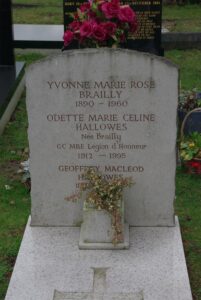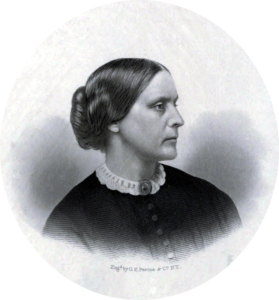 On this day in 1906, social reformer and women’s rights activist Susan B. Anthony died at the age of 86 of heart failure and pneumonia in her home in Rochester, New York. Born on February 15, 1820 in Adams, Massachusetts. She played a pivotal role in the women’s suffrage movement. Born into a Quaker family committed to social equality, she collected anti-slavery petitions at the age of 17. In 1856, she became the New York state agent for the American Anti-Slavery Society.
On this day in 1906, social reformer and women’s rights activist Susan B. Anthony died at the age of 86 of heart failure and pneumonia in her home in Rochester, New York. Born on February 15, 1820 in Adams, Massachusetts. She played a pivotal role in the women’s suffrage movement. Born into a Quaker family committed to social equality, she collected anti-slavery petitions at the age of 17. In 1856, she became the New York state agent for the American Anti-Slavery Society.
In 1851, she met Elizabeth Cady Stanton, who became her lifelong friend and co-worker in social reform activities, primarily in the field of women’s rights. In 1852, they founded the New York Women’s State Temperance Society after Anthony was prevented from speaking at a temperance conference because she was female. In 1863, they founded the Women’s Loyal National League, which conducted the largest petition drive in United States history up to that time, collecting nearly 400,000 signatures in support of the abolition of slavery. In 1866, they initiated the American Equal Rights Association, which campaigned for equal rights for both women and African Americans. In 1868, they began publishing a women’s rights newspaper called The Revolution. In 1869, they founded the National Woman Suffrage Association as part of a split in the women’s movement. In 1890, the split was formally healed when their organization merged with the rival American Woman Suffrage Association to form the National American Woman Suffrage Association, with Anthony as its key force. In 1876, Anthony and Stanton began working with Matilda Joslyn Gage on what eventually grew into the six-volume History of Woman Suffrage.
In 1872, Anthony was arrested for voting in her hometown of Rochester, New York, and convicted in a widely publicized trial. Although she refused to pay the fine, the authorities declined to take further action. In 1878, Anthony and Stanton arranged for Congress to be presented with an amendment giving women the right to vote. Introduced by Sen. Aaron A. Sargent (R-CA), it later became known colloquially as the Susan B. Anthony Amendment. It was ratified as the Nineteenth Amendment to the U.S. Constitution in 1920.
Anthony traveled extensively in support of women’s suffrage, giving as many as 75 to 100 speeches per year and working on many state campaigns. She worked internationally for women’s rights, playing a key role in creating the International Council of Women, which is still active. She also helped to bring about the World’s Congress of Representative Women at the World’s Columbian Exposition in Chicago in 1893.
When she first began campaigning for women’s rights, Anthony was harshly ridiculed and accused of trying to destroy the institution of marriage. Her 80th birthday was celebrated in the White House at the invitation of President William McKinley. She became the first actual woman to be depicted on U.S. coinage when her portrait appeared on the 1979 dollar coin.
At her 86th birthday celebration in Washington D.C., Anthony had spoken of those who had worked with her for women’s rights: “There have been others also just as true and devoted to the cause — I wish I could name every one — but with such women consecrating their lives, failure is impossible!” “Failure is impossible” quickly became a watchword for the women’s movement.
As a teen, Anthony went to parties, and she had offers of marriage when she was older, but there is no record of her ever having a serious romance.
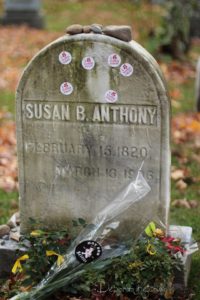 The Final Footprint
The Final Footprint
She was buried at Mount Hope Cemetery, Rochester.
Anthony did not live to see the achievement of women’s suffrage at the national level, but she still expressed pride in the progress the women’s movement had made. At the time of her death, women had achieved suffrage in Wyoming, Utah, Colorado and Idaho, and several larger states followed soon after. Legal rights for married women had been established in most states, and most professions had at least a few women members. 36,000 women were attending colleges and universities, up from zero a few decades earlier.”
Anthony’s death was widely mourned. Clara Barton, founder of the American Red Cross, said just before Anthony’s death, “A few days ago someone said to me that every woman should stand with bared head before Susan B. Anthony. ‘Yes,’ I answered, ‘and every man as well.’ … For ages he has been trying to carry the burden of life’s responsibilities alone… Just now it is new and strange and men cannot comprehend what it would mean but the change is not far away.”
The Nineteenth Amendment, which guaranteed the right of American women to vote, was colloquially known as the Susan B. Anthony Amendment. After it was ratified in 1920, the National American Woman Suffrage Association, whose character and policies were strongly influenced by Anthony, was transformed into the League of Women Voters, which is still an active force in U.S. politics.
Anthony’s papers are held in library collections of Harvard University, Radcliffe Institute, Rutgers University, the Library of Congress, and Smith College.
Another notable final footprint at Mount Hope is Frederick Douglass.
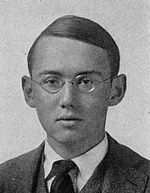 On this day in 1943, author, poet, short story writer novelist, Pulitzer Prize winner, Stephen Vincent Benét, died of a heart attack in New York City at the age of 44. Born on 22 July 1898 in Bethlehem, Pennsylvania. Benét is best known for his book-length narrative poem of the American Civil War, John Brown’s Body (1928), for which he won a Pulitzer Prize in 1929, and for two short stories, “The Devil and Daniel Webster” and “By the Waters of Babylon.” He graduated from Yale.
On this day in 1943, author, poet, short story writer novelist, Pulitzer Prize winner, Stephen Vincent Benét, died of a heart attack in New York City at the age of 44. Born on 22 July 1898 in Bethlehem, Pennsylvania. Benét is best known for his book-length narrative poem of the American Civil War, John Brown’s Body (1928), for which he won a Pulitzer Prize in 1929, and for two short stories, “The Devil and Daniel Webster” and “By the Waters of Babylon.” He graduated from Yale.
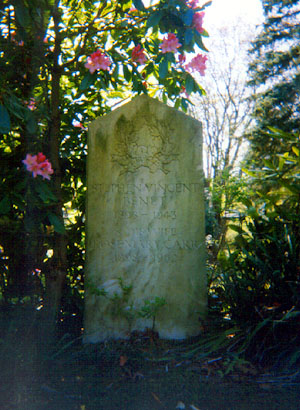
The Final Footprint – Benét is interred in Evergreen Cemetery, Stonington, Connecticut. His wife, Rosemary Carr was interred next to him in 1962. Their graves are marked by an upright marble marker.
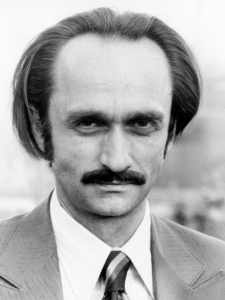 On this day in 1978, actor John Cazale died in New York City from lung cancer with girlfriend Meryl Streep by his side, at the age of 42. Born John Holland Cazale on 12 August 1935 in Revere, Massachusetts. Perhaps best known for his role as Michael Corleone’s big brother Fredo in Francis Ford Coppola‘s Godfather films. During his six-year film career he appeared in five films, each nominated for the Academy Award for Best Picture: The Godfather, The Conversation, The Godfather Part II, Dog Day Afternoon and The Deer Hunter. He appeared in archival footage in The Godfather III, which was nominated for the Best Picture Oscar. He is the only actor to have this multi-film distinction.
On this day in 1978, actor John Cazale died in New York City from lung cancer with girlfriend Meryl Streep by his side, at the age of 42. Born John Holland Cazale on 12 August 1935 in Revere, Massachusetts. Perhaps best known for his role as Michael Corleone’s big brother Fredo in Francis Ford Coppola‘s Godfather films. During his six-year film career he appeared in five films, each nominated for the Academy Award for Best Picture: The Godfather, The Conversation, The Godfather Part II, Dog Day Afternoon and The Deer Hunter. He appeared in archival footage in The Godfather III, which was nominated for the Best Picture Oscar. He is the only actor to have this multi-film distinction.
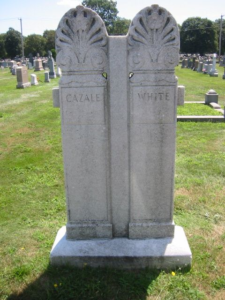 The Final Footprint – Cazale was interred at Holy Cross Cemetery in Malden, Massachusetts. Al Pacino said: “I’ve hardly ever seen a person so devoted to someone who is falling away like John was. To see her (Streep) in that act of love for this man was overwhelming.”
The Final Footprint – Cazale was interred at Holy Cross Cemetery in Malden, Massachusetts. Al Pacino said: “I’ve hardly ever seen a person so devoted to someone who is falling away like John was. To see her (Streep) in that act of love for this man was overwhelming.”
His friend and frequent collaborator, Israel Horovitz, wrote a eulogy, published in the Village Voice on March 27, 1978. In it, he said:
John Cazale happens once in a lifetime. He was an invention, a small perfection. It is no wonder his friends feel such anger upon waking from their sleep to discover that Cazale sleeps on with kings and counselors, with Booth and Kean, with Jimmy Dean, with Bernhardt, Guitry, and Duse, with Stanislavsky, with Groucho, Benny, and Allen. He will make fast friends in his new place. He is easy to love.
His life and career are profiled in the documentary film, I Knew It Was You, directed by Richard Shepard, which premiered at the 2009 Sundance Film Festival.
#RIP #OTD 1995 agent for the UK’s Special Operations Executive (SOE) in France during the Second World War, the first woman to be awarded the George Cross by the UK, awarded the Légion d’honneur by France, Odette Hallowes died in Walton-on-Thames, Surrey, England, aged 82. Burvale Cemetery, Hersham, England
#RIP #OTD 2022 actor (Body Heat, Kiss of the Spider Woman, Children of a Lesser God, Broadcast News, The Big Chill, A History of Violence, A.I. Artificial Intelligence, The Village, Syriana, The Good Shepherd, Mr. Brooks) William Hurt died from prostate cancer at home in Portland, Oregon, aged 71. Cremation
Have you planned yours yet?
Follow TFF on twitter @RIPTFF

